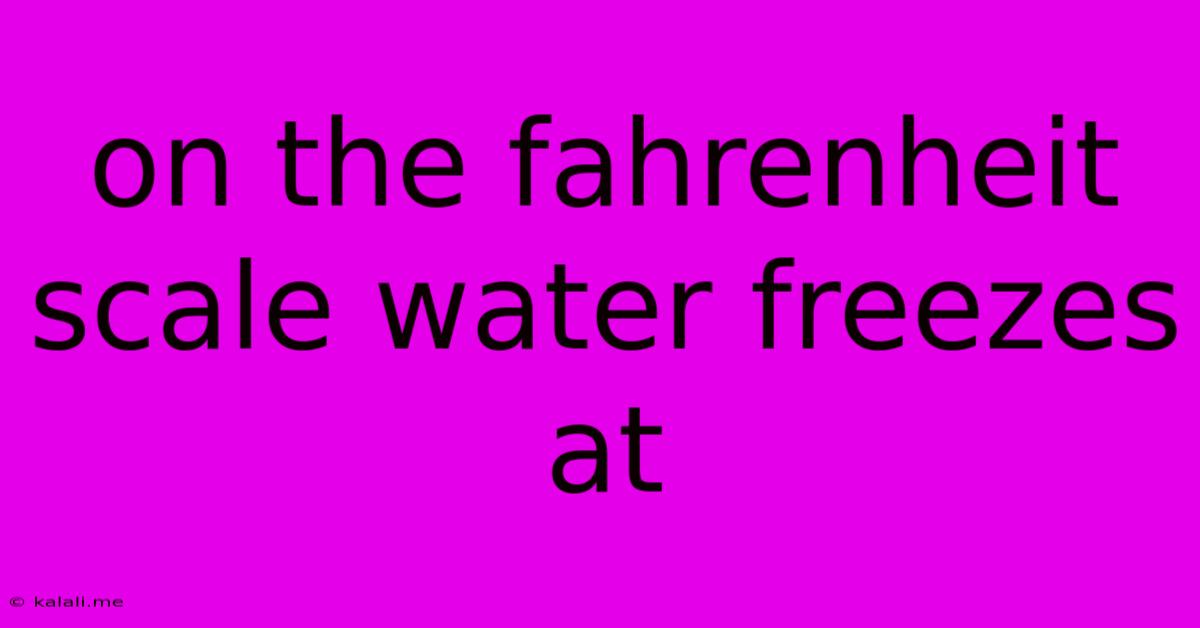On The Fahrenheit Scale Water Freezes At
Kalali
Jun 13, 2025 · 3 min read

Table of Contents
On the Fahrenheit Scale, Water Freezes at 32 Degrees: A Deep Dive into Temperature Measurement
Water freezing at 32 degrees is a fact ingrained in many of us since childhood. But how much do we really understand about the Fahrenheit scale itself, its history, and its continued relevance in today's world? This article will delve into the intricacies of the Fahrenheit scale, explaining why water freezes at 32°F and exploring its comparison with other temperature scales.
The Fahrenheit Scale: A Historical Perspective
The Fahrenheit scale, developed by the German physicist Daniel Gabriel Fahrenheit in 1724, is one of the oldest temperature scales still in use today. Unlike the Celsius scale, which uses the freezing and boiling points of water as its defining points, Fahrenheit's scale was originally based on a series of reference points. These included the temperature of a mixture of ice, water, and ammonium chloride (0°F), the freezing point of water (32°F), and human body temperature (originally set around 96°F, now standardized to 98.6°F).
The choice of these reference points might seem arbitrary now, but they reflected the scientific knowledge and available technology of Fahrenheit's time. While less intuitive than the Celsius scale for many scientific applications, the Fahrenheit scale remains prevalent in certain parts of the world, primarily the United States.
Why 32 Degrees Fahrenheit? Understanding the Scale's Construction
The 32-degree mark for the freezing point of water is not a random number. It's directly linked to the original construction of the Fahrenheit scale. Fahrenheit chose 0°F as the temperature of a mixture of ice, water, and ammonium chloride – a readily reproducible and relatively low temperature point at the time. The freezing point of pure water then became 32°F, establishing a fundamental reference point within the scale. This difference of 32 degrees between the freezing point of water and the ice, water, and ammonium chloride mixture isn't simply arbitrary, but rather a result of the historical development and calibration of the scale.
This historical context is crucial to understanding why water's freezing point is set at 32°F and isn't simply a matter of a coincidental number.
Fahrenheit vs. Celsius: A Comparison
While the Fahrenheit scale is still used, especially in the United States, the Celsius scale (also known as the centigrade scale) is the internationally preferred scale for most scientific and many everyday applications. Celsius is more straightforward, with 0°C representing the freezing point of water and 100°C representing its boiling point at standard atmospheric pressure.
The conversion between Fahrenheit and Celsius is relatively simple, governed by the formula:
- °C = (°F - 32) × 5/9
- °F = (°C × 9/5) + 32
This allows for easy conversion between the two scales, making it possible to easily understand temperatures reported in either system.
The Continued Relevance of the Fahrenheit Scale
Despite the global preference for the Celsius scale, the Fahrenheit scale retains its significance, particularly in the United States where it is still commonly used in everyday life and weather reporting. Understanding this scale and its history is important for anyone working with temperature measurements or seeking a deeper understanding of scientific history and the development of metrology. The persistence of Fahrenheit is a testament to the enduring impact of historical scientific developments and the cultural factors that influence the continued use of certain measurement standards.
In Conclusion:
The freezing point of water at 32 degrees Fahrenheit is not simply a numerical anomaly; it's a cornerstone of the Fahrenheit scale's historical construction and a key element of its legacy. While the Celsius scale has become dominant globally, the Fahrenheit scale continues to hold a place in our understanding of temperature measurement and its historical development.
Latest Posts
Latest Posts
-
Instrument To Measure Height Above Sea Level
Jun 14, 2025
-
What Is The Lcm Of 15 18
Jun 14, 2025
-
Select The Statement That Is True
Jun 14, 2025
-
What Are All Of The Factors Of 44
Jun 14, 2025
-
One Effect Caused By Magnetic Leakage In Transformers Is A
Jun 14, 2025
Related Post
Thank you for visiting our website which covers about On The Fahrenheit Scale Water Freezes At . We hope the information provided has been useful to you. Feel free to contact us if you have any questions or need further assistance. See you next time and don't miss to bookmark.